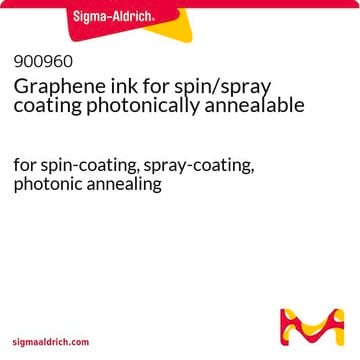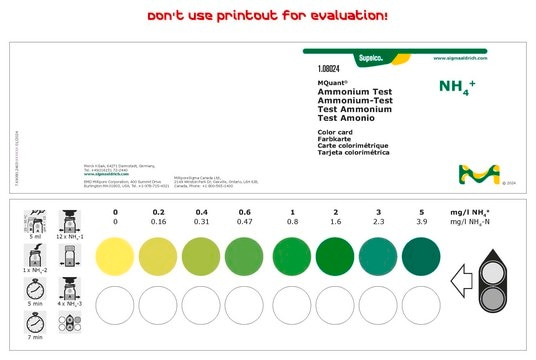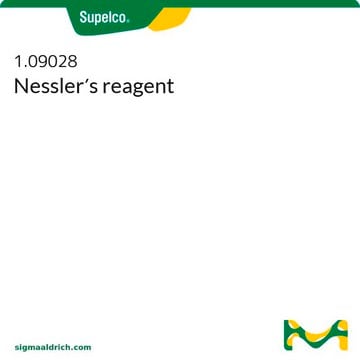Products may be shipped at a different temperature than the recommended long-term storage temperature. If the product quality is sensitive to short-term exposure to conditions other than the recommended long-term storage, it will be shipped on wet or dry-ice. If the product quality is NOT affected by short-term exposure to conditions other than the recommended long-term storage, it will be shipped at ambient temperature. As shipping routes are configured for minimum transit times, shipping at ambient temperature helps control shipping costs for our customers. For more information, please refer to the Storage and Transport Conditions document: https://www.sigmaaldrich.com/deepweb/assets/sigmaaldrich/marketing/global/documents/316/622/storage-transport-conditions-mk.pdf
AA0100
Ammonia Assay Kit
sufficient for 100 assays
Sinónimos:
Ammonia Quantitative Test Kit
About This Item
Productos recomendados
Aplicación
Solo componentes del kit
- Ammonia Assay Reagent 10 vial(s)
- L-Glutamate Dehydrogenase for Ammonia Assay 1 mL/vial
- Ammonia Standard Solution 1 mL/vial
Palabra de señalización
Danger
Frases de peligro
Consejos de prudencia
Clasificaciones de peligro
Eye Irrit. 2 - Resp. Sens. 1
Código de clase de almacenamiento
10 - Combustible liquids
Punto de inflamabilidad (°F)
Not applicable
Punto de inflamabilidad (°C)
Not applicable
Elija entre una de las versiones más recientes:
Certificados de análisis (COA)
¿No ve la versión correcta?
Si necesita una versión concreta, puede buscar un certificado específico por el número de lote.
¿Ya tiene este producto?
Encuentre la documentación para los productos que ha comprado recientemente en la Biblioteca de documentos.
Los clientes también vieron
Artículos
Sigma article discusses tumor cell metabolic pathways, focusing on aerobic glycolysis and mitochondrial activity.
Sigma article discusses tumor cell metabolic pathways, focusing on aerobic glycolysis and mitochondrial activity.
Sigma article discusses tumor cell metabolic pathways, focusing on aerobic glycolysis and mitochondrial activity.
Sigma article discusses tumor cell metabolic pathways, focusing on aerobic glycolysis and mitochondrial activity.
-
How is shipping temperature determined? And how is it related to the product storage temperature?
1 answer-
Helpful?
-
-
How can I determine the shelf life / expiration / retest date of this product?
1 answer-
If this product has an expiration or retest date, it will be shown on the Certificate of Analysis (COA, CofA). If there is no retest or expiration date listed on the product's COA, we do not have suitable stability data to determine a shelf life. For these products, the only date on the COA will be the release date; a retest, expiration, or use-by-date will not be displayed.
For all products, we recommend handling per defined conditions as printed in our product literature and website product descriptions. We recommend that products should be routinely inspected by customers to ensure they perform as expected.
For products without retest or expiration dates, our standard warranty of 1 year from the date of shipment is applicable.
For more information, please refer to the Product Dating Information document: https://www.sigmaaldrich.com/deepweb/assets/sigmaaldrich/marketing/global/documents/449/386/product-dating-information-mk.pdfHelpful?
-
-
In the case of bacterial culture supernatant (BHI broth), should the decolorization process be performed? How?
1 answer-
Any sample solution that is strongly colored and/or has a low ammonia concentration should be decolorized when using this kit. Colored sample solutions often are treated with decolorizing carbon (activated charcoal) to remove color-contributing impurities.
Helpful?
-
-
What is the Department of Transportation shipping information for this product?
1 answer-
Transportation information can be found in Section 14 of the product's (M)SDS.To access the shipping information for this material, use the link on the product detail page for the product.
Helpful?
-
-
Is there a control that can be used to assess the accuracy of Product AA0100, Ammonia Assay Kit?
1 answer-
A convenient control for use with this kit is the Ammonia Standard Solution that is provided in the kit.
Helpful?
-
-
How can I assess the absorbance change of my reagent blank when using Product AA0100, Ammonia Assay Kit?
1 answer-
Generally, an absorbance change of 0.050 or less indicates an acceptable range for the reagent blank. An absorbance change higher than this indicates possible contamination of the reagent (or glassware) with ammonia.
Helpful?
-
-
Which samples should be deproteinized for use with Product AA0100, Ammonia Assay Kit?
1 answer-
The basis for this kit was a Diagnostic procedure for the determination of Ammonia in human plasma, whose total protein concentration is approximately 63 to 83 mg/mL. Thus, any solution whose protein concentration is less than approximately 83 mg/mL should not require deproteinization.
Helpful?
-
Active Filters
Nuestro equipo de científicos tiene experiencia en todas las áreas de investigación: Ciencias de la vida, Ciencia de los materiales, Síntesis química, Cromatografía, Analítica y muchas otras.
Póngase en contacto con el Servicio técnico







